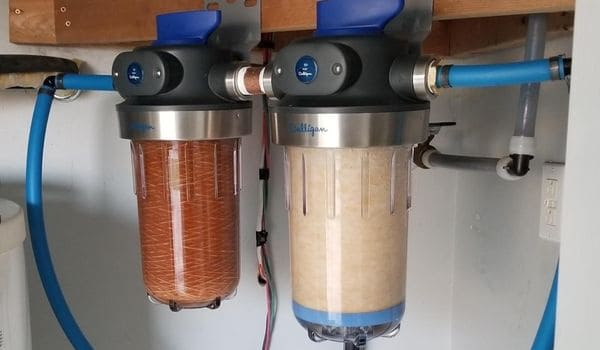Sand’s great for castles — not so much for your kitchen sink. If your well water’s starting to feel more like a beach rinse than a clean pour, you’re not alone. Grit in your glass usually means something’s off with your well, but the good news? It’s fixable.
With the right setup, you can kick the crunch for good — no more surprise sediment in your morning coffee.
🔑 Key Takeaways
- 🌀 A bit of sand won’t hurt — but over time, it can clog pipes and wear down your system.
- 🛠️ Cracked casings, broken screens, or oversized pumps are common sand culprits.
- 🚿 Spin-down filters work for mild grit. Sand separators handle heavier loads.
- 💸 Spin-downs are cheaper and easy to clean. Separators cost more but need less upkeep.
- 🧪 Not sure what’s in your water? Test it first — no guesswork needed.

🛠️ Why Sediment Shows Up in Your Well
A little grit in your water is normal, especially with a new well. But if it suddenly feels like you’re brewing a cup of beach, something might be off.
Here’s what could be stirring things up:
- Cracked Well Casing: The casing is the protective shell around your well — and if it cracks, dirt and debris can sneak in. Even a hairline fracture is enough to let in more than just sand.
- Damaged Well Screen: Screens help keep large particles out, but over time they wear down or break. If the holes get bigger, sediment flows freely.
- Pump Pulling Too Hard: Pumps need to match your well’s capacity. Oversized models can suck up more than just water — they can pull in surrounding grit too.
- Poor Development After Drilling: If your well wasn’t properly “developed” (a post-drilling cleaning process), leftover sediment might still be working its way out.
- Pump Sits Too Low: Ideally, the pump should be positioned 10–20 feet above the bottom of the shaft. Too low, and it’s scooping up more than just water.
💡 Heads-up: If sediment suddenly increases, it’s worth having a professional check your system. It could be a simple fix — or a sign your well needs maintenance.
🧰 What To Do If You Spot Sand in Your Well Water

If sand keeps showing up in your water, don’t just throw a filter at it — that’s treating the symptom, not the source. It’s worth having a professional well contractor take a look before you invest in any equipment.
A pro can inspect your well casing, pump placement, and screen to spot mechanical issues that may be stirring up sediment. Sometimes it’s something simple — like the pump sitting too low — other times, it’s a cracked screen or poorly developed well.
💡Good to Know: Even a well that was fine can start pulling in grit over time. Groundwater shifts, aquifers change, and equipment wears out — it’s not always anyone’s fault.
🔧How to Remove Sand from Well Water

Once you’ve ruled out pump or well issues, it’s time to deal with the sand that’s already getting in. The good news? You’ve got options — and none of them involve scooping grit out of your glass.
Here are two of the most effective solutions:
🔁 Spin-Down Sediment Filters
Spin-down filters catch larger particles like sand before they reach your plumbing. Water flows through a mesh screen that traps debris — and when it fills up, you just twist a valve to flush it out.
- Great for moderate sediment loads
- Mesh sizes are customizable (30–60 works for most sand)
- Reusable and budget-friendly
- Best installed after the pressure tank
💡Heads-up: Cheaper polyester screens work fine short-term, but stainless steel holds up better to abrasive particles like sand.
🌀 Centrifugal Sand Separators
These filters use spinning force — not mesh — to sling sand and grit into a holding chamber. They’re low-maintenance and perfect for homes with: heavy sediment or high water usage.
- Installed before the pressure tank
- Works passively — no filter changes
- Can handle larger sediment volumes
- Many models offer auto-purge options
They’re a bit more of an upfront investment and may require a plumber to install — but they’re virtually hands-off once they’re up and running.
⚖️ Spin-Down Filters vs. Centrifugal Separators
Both systems clear sand like champs — but they work a bit differently. If you’re stuck choosing between the two, here’s a quick side-by-side to help you decide.
| Filter Type | Average Lifespan |
|---|---|
| 🌀 Spin-Down Filter | Clean every 3–4 months |
| 🌪️ Centrifugal Sand Separator | Purge every 6 months |
| 🧻 Sediment Filter (Cartridge) | 3–6 months (if pre-filtered) |
| 💧 Paper/String Filters | 2–3 months (not ideal for sand) |
| 🔧 Well Pump & Casing Maintenance | Inspect every 1–2 years |
💡 Helpful to Know: You can also combine both systems. A centrifugal separator can handle the heavy lifting, while a spin-down filter gives you a secondary defense against smaller particles before they hit your plumbing.
❓ Sand in Your Water – What People Ask Most

Even with filters in place, well owners still have questions. Let’s clear a few of the big ones up:
🧵 Do paper or string filters work for sand?
Not really — at least not on their own. These filters are better for fine particles like silt or rust. Sand tends to clog them fast, so use a screen or separator first to avoid constant replacements.
🧪 Should I test my well for sediment?
Yes — even if the sand is obvious. Sediment testing can reveal whether you’re dealing with just sand or a mix of iron, silt, and other particles. We recommend basic water test — it’ll help match the right filter to your problem.
🔁 Can I use a water softener with a sand filter?
Absolutely — and you probably should. Sand can wreck a softener’s resin bed. Putting a sand filter before your softener protects it from damage and keeps everything running smoothly.
🧽 How often do I need to clean sand filters?
It depends on how much sand you’re dealing with and your water use. As a general rule:
- Spin-down filters: clean every 3–4 months
- Centrifugal separators: purge every 6 months More sand = more maintenance.
💲 What do sand filters cost?
Centrifugal separators: $300–$600 depending on features Both are reusable and long-lasting with basic care, so they’re a smart investment.
Spin-down filters: around $60–$100
🧠 Final Thoughts
Sand in your well water isn’t just annoying — it’s a warning sign. Whether it’s a trickle of grit in your glass or a full-on pipe-clogging mess, it usually means something’s off with your system.
But the fix doesn’t have to be complicated.
A simple spin-down filter might be all you need. Or maybe your well just needs a quick inspection to catch a cracked screen or pump issue early. And if you’ve got heavy sediment, a centrifugal separator could save your pump, pipes, and sanity.
✅ Bottom line:
If you’re seeing sand, don’t ignore it — but don’t panic either. Start with a water test, check your well setup, and consider the right filtration for your situation. It’s not about overhauling everything — just making smart, targeted upgrades that protect your water (and your wallet).
Need help getting started? Check out our guide on how deep a well should be for drinking water.
 101 people found this helpful. Was this guide helpful to you?
101 people found this helpful. Was this guide helpful to you? 

